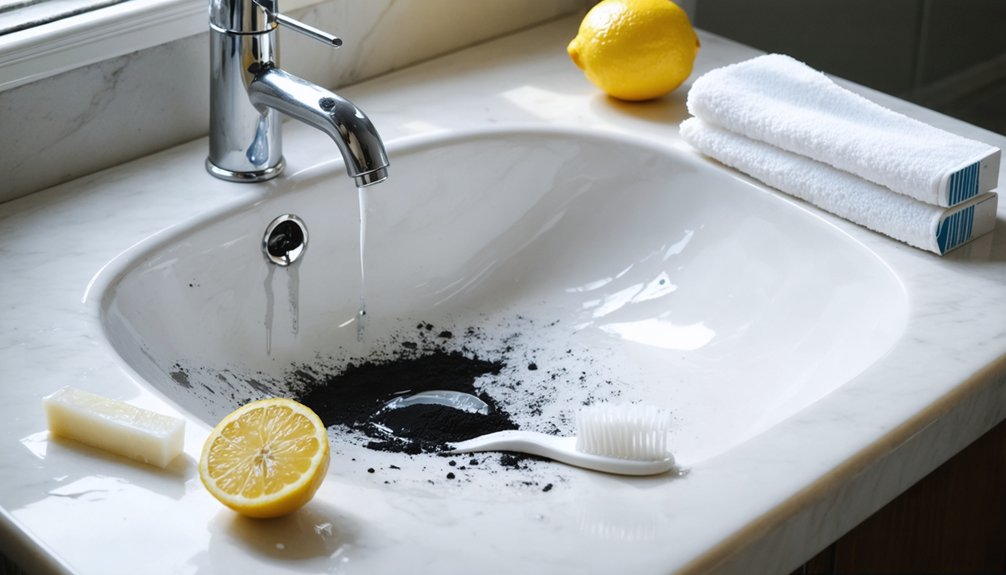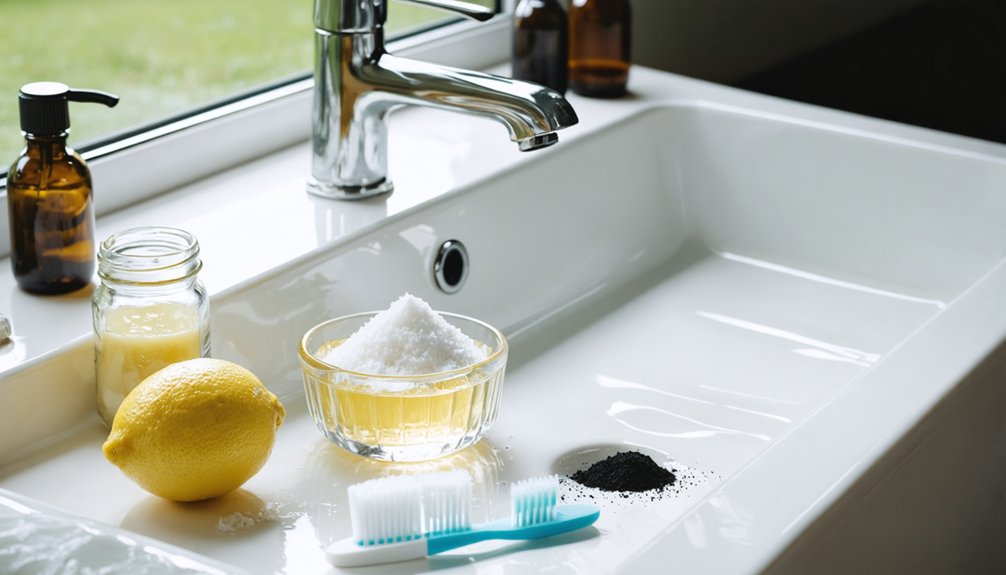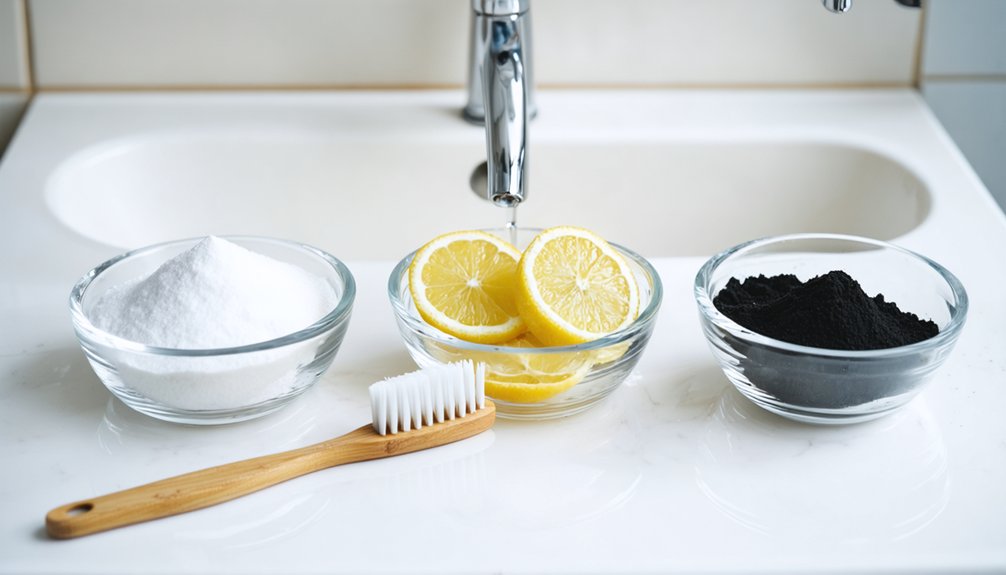DIY teeth whitening methods are safe when you follow professional guidelines and use approved ingredients. Natural options like baking soda provide gentle abrasion, while enzymes effectively break down stains without damaging enamel. You’ll need to monitor for sensitivity and stick to recommended concentrations of active ingredients like hydrogen peroxide. When used correctly, these methods can achieve results comparable to professional treatments while preserving your oral health. Understanding proper application techniques will guarantee your whitening success.
Key Takeaways
- Natural ingredients like baking soda and Dead Sea salt provide gentle abrasion without damaging tooth enamel.
- Enzyme-based whitening methods break down stains while preserving tooth structure and maintaining cell viability.
- Safe DIY ingredients contain regulated concentrations of active ingredients, similar to professional take-home treatments.
- Natural solutions like coconut oil reduce bacteria causing yellowing while protecting enamel integrity.
- Professional recommendations ensure DIY methods follow clinically tested guidelines for safe at-home application.
Understanding Safe Ingredients for Natural Teeth Whitening
While many people seek quick fixes for teeth whitening, understanding which natural ingredients are safe and effective is essential for maintaining long-term oral health.
Natural whitening ingredients like baking soda and Dead Sea salt provide gentle abrasion to remove surface stains without damaging your enamel when used properly. Brushing with baking soda a few times per week creates an alkaline environment that inhibits bacterial growth.
Safe bleaching agents such as diluted hydrogen peroxide can effectively whiten teeth, especially when combined with baking soda. However, you’ll need to monitor concentration levels and frequency of use to prevent sensitivity. Strawberries mixed with baking soda can help remove surface stains due to their natural malic acid content.
For added protection, look for products containing hydroxyapatite, which helps remineralize enamel during the whitening process.
Coconut oil offers a gentle alternative through oil pulling, reducing bacteria that cause yellowing while preserving enamel integrity.
Remember to use these ingredients as supplements to, not replacements for, your regular oral hygiene routine.
The Science Behind Enzymatic Whitening Methods
Natural enzymes like bromelain, found in pineapple, offer a gentler teeth-whitening alternative by breaking down protein-based stains without harsh chemicals.
You’ll find that these enzymes work by specifically targeting and cleaving stain molecules while preserving your tooth enamel’s integrity. The gentle oxidation process helps break down surface stains gradually without compromising the tooth structure.
Clinical studies show that enzyme-based whitening methods can achieve visible results comparable to peroxide treatments but with considerably less risk of sensitivity or enamel damage. Unlike traditional whitening products that use carbamide peroxide, these natural enzyme solutions maintain cell viability above 70%.
Natural Enzyme Whitening Benefits
Ever wondered how enzymes can naturally brighten your smile? Unlike harsh peroxide treatments, natural enzyme whitening offers remarkable stain removal benefits while protecting your teeth’s structure.
These proteolytic enzymes, such as papain, work by breaking down the protein layers that bind stains to your enamel, without damaging the tooth’s mineral content. While enzymes work gradually, they provide a safe dental whitening option without the temporary sensitivity and gum irritation common with other methods. Consulting with a licensed dental professional is recommended before starting any whitening regimen.
You’ll appreciate how enzyme benefits extend beyond whitening. They actively fight bacteria by weakening biofilm structures, making your regular brushing more effective.
Your gums also benefit from the anti-inflammatory properties, reducing irritation and supporting overall oral health. For those with sensitive teeth, enzyme-based whitening provides a gentler alternative to chemical treatments, as it avoids the oxidative stress and demineralization risks associated with peroxide bleaching methods.
How Bromelain Works Safely
Among enzymatic whitening agents, bromelain stands out as a remarkably safe and effective solution for teeth whitening. The enzymatic safety of bromelain lies in its selective targeting of protein-based stains without damaging your tooth’s enamel structure.
Unlike traditional peroxide treatments, bromelain doesn’t generate harmful reactive oxygen species that can erode your teeth.
The bromelain benefits extend beyond just whitening. You’ll find it works by breaking down the protein pellicle layers where stains accumulate, while simultaneously providing antimicrobial and anti-inflammatory support for your oral health.
When combined with peroxides, it enhances bleaching efficiency while reducing potential damage. The enzyme maintains stability at pH levels between 7 and 10, ensuring controlled activity that’s gentle enough for sensitive teeth yet effective for noticeable whitening results.
Gentle Stain Breaking Action
Understanding the science of enzymatic whitening reveals a remarkably precise mechanism at work. When you use products containing enzymes like papain and bromelain, they target specific organic compounds that cause staining on your teeth. These natural proteins break down the molecular bonds that hold stains to your enamel.
What makes enzyme efficiency so impressive is its selective approach to stain removal. Instead of harsh chemicals, these enzymes work by breaking peptide bonds in proteins that trap stains on your teeth’s surface. For optimal safety and effectiveness, these whitening methods employ secure protocols that protect users during the treatment process.
You’ll find this process mimics your body’s natural stain-fighting abilities, making it a biocompatible choice for whitening. The enzymatic action is gentle yet effective, offering you a safer alternative to traditional peroxide-based methods while maintaining professional-grade results.
Professional Recommendations for At-Home Treatments
You’ll want to exclusively use dentist-approved whitening products that have been clinically tested and verified by organizations like the ADA for safe at-home use.
Take-home professional whitening treatments offer gradual but reliable results compared to risky DIY alternatives.
When applying any whitening treatment, follow the manufacturer’s instructions precisely and never exceed recommended application times or frequency of use.
Watch carefully for signs of tooth sensitivity or gum irritation, and immediately discontinue use while consulting your dentist if these symptoms develop.
Professional whitening kits typically contain under 6% peroxide concentrations to ensure safety while still being effective.
Dentist-Approved Products Only
Professional-grade teeth whitening products endorsed by dentists offer a reliable path to achieving a brighter smile at home.
You’ll find proven options like Crest Whitestrips, Colgate Pen, and Opalescence Trays that deliver consistent results while protecting your oral health.
For sensitive teeth, Sensodyne Toothpaste provides a gentler approach, while Philips Zoom custom trays offer personalized treatment.
A dentist consultation is recommended as whitening should only be performed in a healthy oral environment.
- Crest Whitestrips contain effective hydrogen peroxide concentrations that break down stains without damaging enamel.
- Colgate Pen’s precision applicator guarantees targeted whitening while minimizing gum contact.
- Opalescence Trays feature 15% hydrogen peroxide with added sensitivity-reducing ingredients.
- Professional-grade products include protective ingredients like fluoride and potassium nitrate to maintain tooth strength during whitening.
Safe Application Guidelines
While selecting dentist-approved products is important, proper application techniques determine the safety and effectiveness of at-home teeth whitening. For safe usage, you’ll need to follow your dentist’s prescribed protocols precisely, never exceeding recommended treatment times or frequencies.
Product selection should align with your specific oral health needs, considering factors like existing dental work or sensitivity. You must avoid staining foods and beverages for at least 48 hours after treatment, maintain proper hydration, and practice thorough oral hygiene.
If you have crowns, fillings, or veneers, consult your dentist about potential uneven whitening. Before starting any whitening regimen, guarantee your teeth are professionally cleaned and address any underlying dental issues.
Remember to space out whitening sessions appropriately to prevent enamel damage and sensitivity.
Monitor Side Effects Carefully
Monitoring potential side effects is essential when undertaking any at-home teeth whitening regimen. To guarantee your safety and best results, you’ll need to carefully observe any changes during and after treatment.
Professional supervision remains the best approach, but if you’re using DIY methods, stay vigilant for adverse reactions.
- Watch for tooth sensitivity, especially when consuming hot or cold items, and reduce treatment frequency if discomfort occurs.
- Check your gums daily for signs of irritation or redness, stopping treatment immediately if these symptoms appear.
- Document any changes in existing dental work, as restorations may react differently to whitening agents.
- Schedule regular dental check-ups to assess your treatment’s progress and address any concerns promptly with your dentist.
Best Practices for DIY Teeth Whitening Safety
Before starting any DIY teeth whitening regimen, understanding proper safety protocols is crucial to prevent potential damage to your teeth and gums.
Always choose ADA-approved products with regulated concentrations of whitening agents, typically 10% carbamide peroxide or 3.6% hydrogen peroxide for home use.
To protect against sensitive gums and enamel erosion, use custom-fitted trays rather than generic ones, and follow application instructions precisely.
Don’t exceed recommended treatment times or mix your own solutions. Monitor your teeth closely for sensitivity and stop treatment if discomfort occurs.
For best results, maintain regular touch-ups instead of aggressive treatments, and avoid abrasive DIY remedies like baking soda or citrus juices.
When in doubt, consult your dentist before beginning any whitening routine to ascertain it’s appropriate for your oral health.
Common Mistakes to Avoid When Whitening at Home

Many people unknowingly damage their teeth through improper whitening practices at home. Understanding common whitening mistakes can help prevent enamel erosion risks and maintain your oral health while achieving a brighter smile.
- Don’t exceed recommended treatment times – leaving whitening products on longer than directed increases sensitivity and damages tooth enamel.
- Avoid using ill-fitting generic trays that leak gel onto your gums, causing irritation and uneven results.
- Skip DIY remedies like lemon juice or baking soda mixtures that erode enamel and may cause permanent damage.
- Never attempt whitening if you have untreated cavities, gum disease, or dental work without consulting your dentist first.
For best results and safety, always follow product instructions carefully and consider professional guidance before starting any whitening regimen.
Proven Natural Alternatives to Chemical Bleaching
While chemical bleaching remains a popular teeth whitening method, several natural alternatives have emerged that can safely brighten your smile when used correctly.
Among safe alternatives, baking soda stands out as a proven natural whitening agent when used in moderation. You’ll achieve gradual results by gently removing surface stains without significant enamel damage.
Low-concentration hydrogen peroxide (3-10%) offers another viable option when following manufacturer instructions strictly.
However, be cautious with trendy solutions like activated charcoal, oil pulling, or citrus acids. Despite marketing claims, these methods either lack scientific evidence or pose risks to your enamel.
To maintain both safety and effectiveness, focus on gentle, proven approaches like baking soda paste or controlled peroxide applications rather than potentially harmful DIY treatments.
Monitoring and Managing Tooth Sensitivity

Tooth sensitivity represents a common side effect of DIY teeth whitening treatments. The peroxide-based ingredients can temporarily demineralize your enamel, exposing microscopic channels that lead to nerve centers.
For effective sensitivity management, you’ll need to monitor your symptoms and take preventive steps before, during, and after whitening.
- Start using desensitizing toothpaste containing potassium nitrate two weeks before whitening.
- Apply protective desensitizing gels before each whitening session.
- Take OTC pain relievers as needed for immediate discomfort relief.
- Avoid hot, cold, and acidic foods during treatment.
If you experience severe or persistent sensitivity beyond two weeks, consult your dentist immediately.
They can evaluate underlying issues and adjust your whitening protocol to prevent complications while achieving your desired results.
Key Signs Your DIY Method Is Working Safely
After addressing sensitivity concerns, recognizing the signs of safe and effective DIY whitening becomes paramount for your oral health.
When using natural whitening methods, you’ll notice gradual, uniform color improvement across your teeth without sudden dramatic changes. Your enamel should remain smooth and intact, free from chalky spots or roughness. Safe practices will maintain healthy pink gums without persistent irritation or chemical burns.
Monitor your results closely – if you’re following product instructions correctly, you shouldn’t experience prolonged tooth sensitivity or gum problems.
Look for whitening products that clearly disclose their peroxide concentrations and carry proper safety certifications. If you notice uneven whitening, persistent sensitivity, or gum irritation, discontinue use immediately and consult your dentist.
Frequently Asked Questions
Can DIY Whitening Methods Interact With Existing Dental Fillings or Crowns?
DIY whitening agents can negatively affect filling compatibility and crown durability, since restorations won’t whiten like natural teeth. You’ll risk uneven results and potential damage to your dental work.
How Long Should I Wait Between Different Whitening Treatments?
Want to maintain healthy teeth while whitening? You’ll need to wait 6-12 months between professional treatments, or 2-3 months between at-home whitening sessions, respecting proper treatment intervals to protect enamel health.
Will Whitening Agents Affect the Strength of My Tooth Enamel?
Professional whitening agents can temporarily soften your tooth enamel, but it’s reversible with proper use. Your saliva naturally rehydrates teeth, restoring strength. Avoid overuse to prevent lasting sensitivity or damage.
Are Whitening Results Permanent or Do They Require Periodic Maintenance?
Your whitening results aren’t permanent. You’ll need regular maintenance and touch-ups every 6-12 months, depending on your whitening method. Following good oral hygiene and avoiding staining foods extends treatment longevity.
Can I Whiten My Teeth While Wearing Orthodontic Braces?
90% of dentists advise against whitening with braces. You’ll risk increased whitening sensitivity, uneven results, and braces discomfort. Wait until after your orthodontic treatment for safe, consistent brightening results.
References
- https://pmc.ncbi.nlm.nih.gov/articles/PMC9915942/
- https://pmc.ncbi.nlm.nih.gov/articles/PMC4058574/
- https://www.nature.com/articles/s41407-019-0059-9
- https://www.frontiersin.org/journals/dental-medicine/articles/10.3389/fdmed.2021.687507/full
- https://www.urmc.rochester.edu/news/publications/health-matters/diy-teeth-whitening-too-good-to-be-true
- https://www.nature.com/articles/s41405-024-00227-2
- https://www.ada.org/resources/ada-library/oral-health-topics/whitening
- https://www.todaysrdh.com/what-the-research-shows-regarding-the-efficacy-of-dental-whitening-options/
- https://wayzatadental.com/natural-teeth-whitening/
- https://www.healthline.com/nutrition/whiten-teeth-naturally



